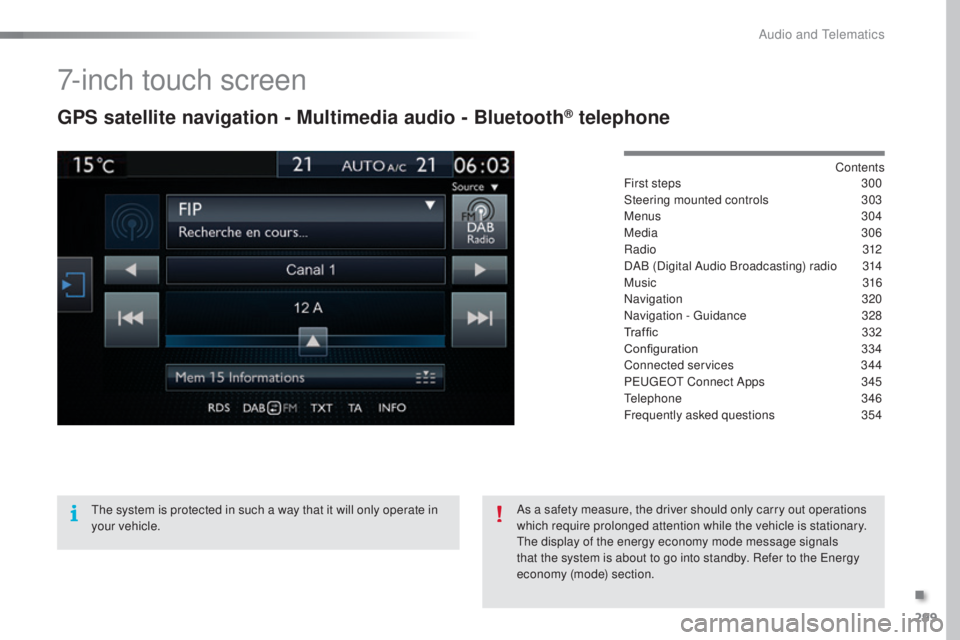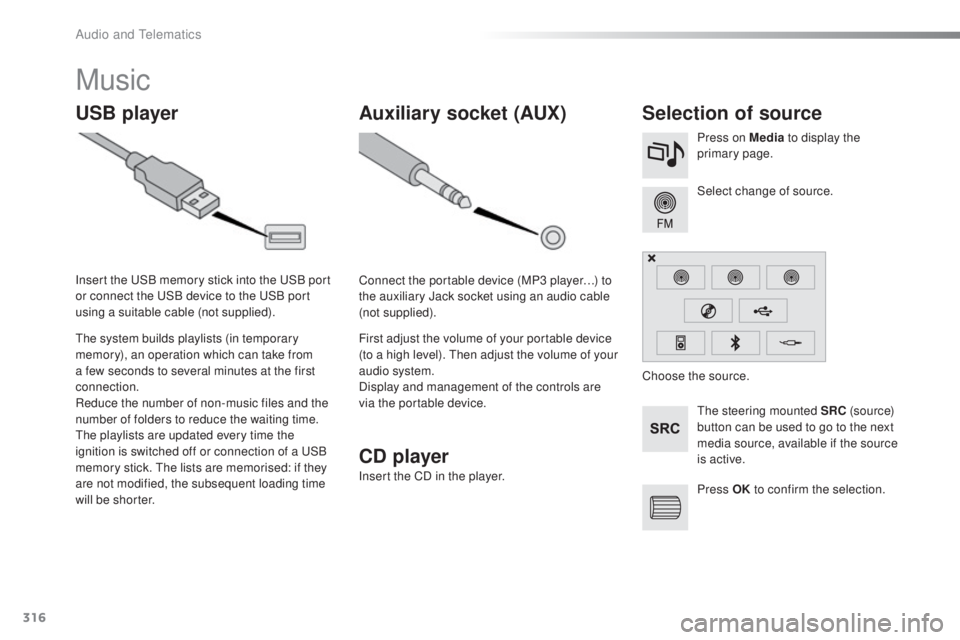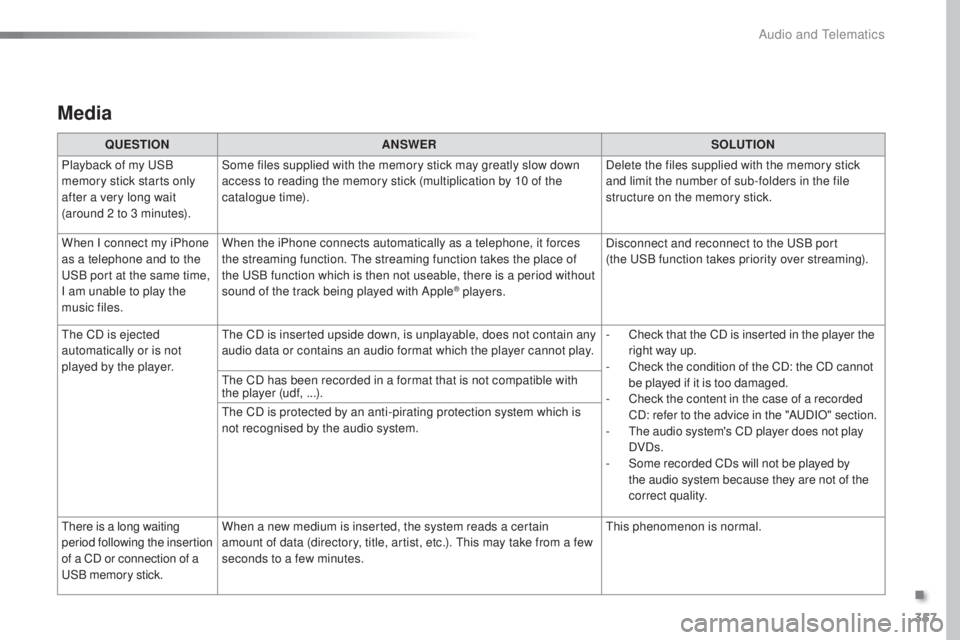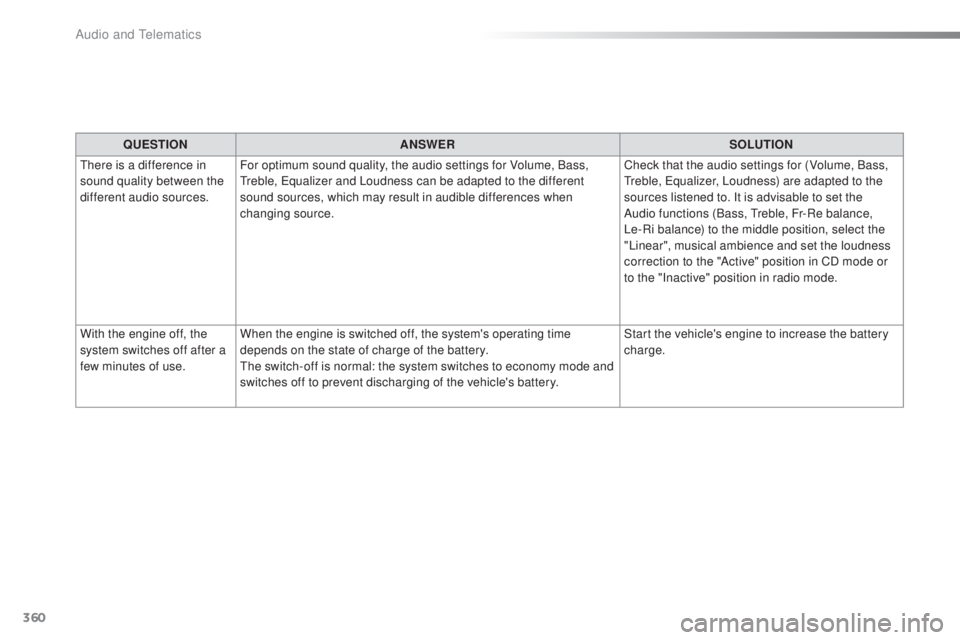2016 Peugeot 308 Music
[x] Cancel search: MusicPage 12 of 398

10
308_en_Chap00c_eco-conduite_ed02-2015
Optimise the use of your gearbox
With a manual gearbox, move off gently and change up without waiting.
During acceleration change up early.
With an automatic or electronic gearbox, give preference to automatic
mode and avoid pressing the accelerator pedal heavily or suddenly.
Control the use of your electrical
equipment
Before moving off, if the passenger compartment is too warm, ventilate it
by opening the windows and air vents before using the air conditioning.
Above 30 mph (50 km/h), close the windows and leave the air vents
open.
Remember to make use of equipment that can help keep the
temperature in the passenger compartment down (sunroof and window
blinds...).
Switch off the air conditioning, unless it has automatic regulation, as
soon as the desired temperature is attained.
Switch off the demisting and defrosting controls, if not automatic.
Switch off the heated seat as soon as possible.
Switch off the headlamps and front foglamps when the level of light
does not require their use.
Avoid running the engine before moving off, particularly in winter; your
vehicle will warm up much faster while driving.
As a passenger, if you avoid connecting your multimedia devices
(film, music, video game...), you will contribute towards limiting the
consumption of electrical energy, and so of fuel.
Disconnect your portable devices before leaving the vehicle.
eco-driving
eco-driving is a range of everyday practices that allow the motorist to optimise their fuel consumption and CO2 emissions.
Drive smoothly
Maintain a safe distance between vehicles, use engine braking rather
than the brake pedal, and press the accelerator progressively. these
practices contribute towards a reduction in fuel consumption and
CO
2 emissions and also helps reduce the background traffic noise.
If y
our vehicle has cruise control, make use of the system at speeds
above 25 mph (40 km/h) when the traffic is flowing well.
the g
ear shift indicator invites you engage the most suitable gear: as
soon as the indication is displayed in the instrument panel, follow it
straight away.
For vehicles fitted with an electronic or automatic gearbox, this
indicator appears only in manual mode.
eco-driving
Page 85 of 398

83
308_en_Chap03_ergonomie-et-confort_ed02-2015
F to connect a 12 V accessory (maximum
p ower: 120 Watts), lift the cover and
connect a suitable adaptor. It permits the connection of a portable device
to listen to your music files via the vehicle's
speakers.
the m
anagement of the files is done using your
portable device.
It allows the connection of a portable device,
such as a digital audio player of the iPod® type
or a uSB m
emory stick.
It reads the audio files which are transmitted to
your audio system and played via the vehicle's
speakers.
You can manage these files using the steering
mounted controls or the audio system.
12 V accessory
socket Auxiliary socketuSB po
rt
For more information on the use of
this equipment, refer to the "Audio and
telematics" section.
When a
uSB p
ort is used, the portable
device charges automatically.
While charging, a message is displayed
if the current consumption of the
portable device exceeds the power
rating of the port.
For more information on using this
equipment, refer to the "Audio and
telematics" section.
Observe the maximum power rating to
avoid damaging your accessory.
the c
onnection of an electrical device
not approved by Peu
geOt, su
ch as a uSB c
harger, may adversely affect the
operation of vehicle electrical systems,
causing faults such as poor telephone
reception or inter ference with displays
in the screens.
3
ease of use and comfort
Page 301 of 398

299
308_en_Chap10c_SMegplus_ed02-2015
7-inch touch screen
GPS satellite navigation - Multimedia audio - Bluetooth® telephone
Contents
First steps 30 0
Steering mounted controls
30
3
Menus
3
04
Media
3
06
Radio
3
12
DAB (Digital Audio Broadcasting) radio
31
4
Music
3
16
Navigation
32
0
Navigation -
guid
ance
32
8
Traffic
332
C
onfiguration
33
4
Connected services
34
4
P
eu
ge
Ot C
onnect Apps
34
5
tele
phone
34
6
Frequently asked questions
35
4
the s
ystem is protected in such a way that it will only operate in
your vehicle. As a safety measure, the driver should only carry out operations
which require prolonged attention while the vehicle is stationary.
the d
isplay of the energy economy mode message signals
that the system is about to go into standby. Refer to the
ene
rgy
economy (mode) section.
.
Audio and telematics
Page 318 of 398

316
308_en_Chap10c_SMegplus_ed02-2015
Music
USB playerSelection of source
the steering mounted SRC ( s o u r c e)
button can be used to go to the next
media source, available if the source
is active. Select change of source. Press on Media to display the
primary page.
the s
ystem builds playlists (in temporary
memory), an operation which can take from
a few seconds to several minutes at the first
connection.
Reduce the number of non-music files and the
number of folders to reduce the waiting time.
the p
laylists are updated every time the
ignition is switched off or connection of a
uSB
m
emory stick.
the l
ists are memorised: if they
are not modified, the subsequent loading time
will be shorter. Insert the
uSB m
emory stick into the
uSB p
ort
or connect the
uSB d
evice to the
uSB p
ort
using a suitable cable (not supplied).
Auxiliary socket (AUX)
Connect the portable device (MP3 player…) to
the auxiliary Jack socket using an audio cable
(not supplied).
First adjust the volume of your portable device
(to a high level).
the
n adjust the volume of your
audio system.
Display and management of the controls are
via the portable device. Choose the source.
Press OK to confirm the selection.
CD player
Insert the CD in the player.
Audio and telematics
Page 342 of 398

340
308_en_Chap10c_SMegplus_ed02-2015
Audio settings
Press on Configuration to display
the primary page.
Select " Audio settings ".
Select " Ambience " or "Balance " or
" Sound effects " or "Ringtones " or
" Voice ". On-board audio: Arkamys© Sound
Staging optimises sound distribution in
the the passenger compartment.the
distribution (or spatialisation using
the Arkamys© system) of sound is an
audio process that allows the audio
quality to be adapted to the number of
listeners in the vehicle.
Available only with the 6 -speaker
configuration.
the a
udio settings ( Ambience, Bass,
Tr e b l e and Loudness ) are different
and independent for each sound
source.
the se
ttings for distribution and
balance are common to all sources.
-
" A
mbience " (choice of 6 musical
ambiences)
-
" Ba
ss "
-
" T
r e b l e "
-
" L
oudness " (Activate/Deactivate)
-
" B
alance " ("Driver ", "All
passengers ", "Front only ")
-
" A
udio setting on touch screen "
-
" V
olume linked to vehicle
speed: " (Activate/Deactivate)
Audio and telematics
Page 359 of 398

357
308_en_Chap10c_SMegplus_ed02-2015
Media
QUESTIONANSWER SOLUTION
Playback of my
uSB
m
emory stick starts only
after a very long wait
(around 2 to 3 minutes). Some files supplied with the memory stick may greatly slow down
access to reading the memory stick (multiplication by 10 of the
catalogue time).
Delete the files supplied with the memory stick
and limit the number of sub-folders in the file
structure on the memory stick.
When I connect my iPhone
as a telephone and to the
uSB p
ort at the same time,
I am unable to play the
music files. When the iPhone connects automatically as a telephone, it forces
the streaming function.
the s
treaming function takes the place of
the
uSB f
unction which is then not useable, there is a period without
sound of the track being played with Apple
® players. Disconnect and reconnect to the
uSB p
ort
(the
uSB f
unction takes priority over streaming).
the C
D is ejected
automatically or is not
played by the player.
the C
D is inserted upside down, is unplayable, does not contain any
audio data or contains an audio format which the player cannot play. -
Ch
eck that the CD is inserted in the player the
right way up.
-
Ch
eck the condition of the CD: the CD cannot
be played if it is too damaged.
-
Ch
eck the content in the case of a recorded
CD: refer to the advice in the "A
uDI
O" section.
-
t
he a
udio system's CD player does not play
DVDs.
-
So
me recorded CDs will not be played by
the audio system because they are not of the
correct quality.
the C
D has been recorded in a format that is not compatible with
the player (udf, ...).
the C
D is protected by an anti-pirating protection system which is
not recognised by the audio system.
there
is a long waiting
period following the insertion
of a CD or connection of a
uSB
memory stick. When a new medium is inserted, the system reads a certain
amount of data (directory, title, artist, etc.).
thi
s may take from a few
seconds to a few minutes.
thi
s phenomenon is normal.
.
Audio and telematics
Page 361 of 398

359
308_en_Chap10c_SMegplus_ed02-2015
Settings
QUESTIONANSWER SOLUTION
In changing the setting
of treble and bass the
equalizer setting is
deselected.
the
selection of an equalizer setting imposes the balance settings.
Modifying one without the other is not possible. Modify the balance or equalizer settings to obtain
the desired musical ambience.
In changing the equalizer
setting, treble and bass
return to zero.
When changing the
balance settings, the
distribution setting is
deselected.
the se
lection of a distribution setting imposes the balance settings.
Modifying one without the other is not possible. Modify the balance or distribution settings to
obtain the desired musical ambience.
When changing an
distribution setting,
the balance setting is
deselected.
.
Audio and telematics
Page 362 of 398

360
308_en_Chap10c_SMegplus_ed02-2015
QUESTIONANSWER SOLUTION
the
re is a difference in
sound quality between the
different audio sources. For optimum sound quality, the audio settings for Volume, Bass,
tre
ble,
equ
alizer and Loudness can be adapted to the different
sound sources, which may result in audible differences when
changing source. Check that the audio settings for (Volume, Bass,
tre
ble,
equ
alizer, Loudness) are adapted to the
sources listened to. It is advisable to set the
Audio functions (Bass,
tre
ble, Fr-Re balance,
Le-Ri balance) to the middle position, select the
"Linear", musical ambience and set the loudness
correction to the "Active" position in CD mode or
to the "Inactive" position in radio mode.
With the engine off, the
system switches off after a
few minutes of use. When the engine is switched off, the system's operating time
depends on the state of charge of the battery.
the s
witch-off is normal: the system switches to economy mode and
switches off to prevent discharging of the vehicle's battery. Start the vehicle's engine to increase the battery
charge.
Audio and telematics